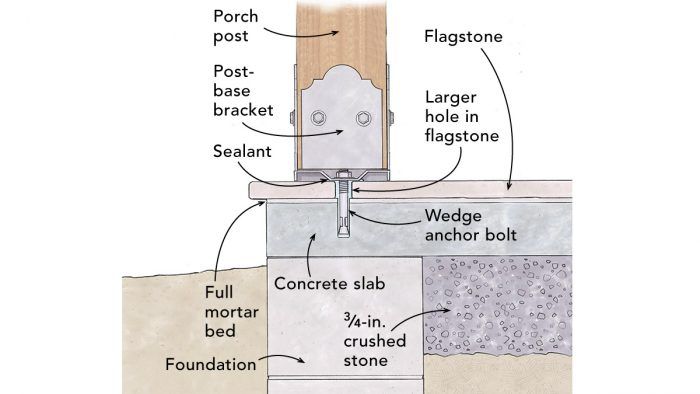Setting Bases for Porch Posts
Prevent structural posts from cracking stone by following these tips when installing the anchor bolts.

I want to surface a front stoop with stone. The shed roof over the stoop is 12 ft. long and 8 ft. wide, has a 4-in-12 pitch, and is covered in standing-seam metal. I’m planning to pour 3-1/2 in. of concrete and top it off with 12-in. by 12-in. by 1-in. flagstone. I’m wondering the best way to manage the permanent posts. I would like to set them on top of the stone and secure them with the kind of decorative post-base bracket that keeps the post about an inch up off the surface. However, I’m worried about cracking the stone when installing the base. How can I avoid this?
—Laurie Moody, Lexington, Ky.
Steven Fechino, engineering and construction manager at Mortar Net Solutions, replies: For starters, I recommend pouring your concrete on top of at least 6 in. of compacted, 3/4-in./#57 aggregate stone. And while the posts won’t be carrying much weight given the size of the porch roof, it’s critical that the stone pavers are set in a full bed of mortar. Any voids in the mortar near the point loads will ultimately lead to cracks.
Standard post bases require one or more anchor bolts to secure them to the masonry surface. When drilling the hole for the anchor bolt, don’t use the hammer action on your drill until you pass through the stone and reach the concrete. Take your time when drilling the pavers and use water to cool the bits and the stone as you go. I would also recommend coming back and drilling a slightly larger hole in just the stone so that only the concrete is holding the anchor bolt, not the stone. Wedge anchor bolts have a minimum embedment-depth requirement, so make sure you purchase a bolt that is long enough to meet that depth.
Don’t install wedge anchor bolts too close to the edge of the concrete or you could create a large fissure in both the concrete and the pavers. One common rule of thumb is to keep the bolt at least five times the bolt’s thickness from the edge of concrete. That means if you’re using a 1/2-in. bolt it should be no closer than 2-1/2 in. from the edge, but more is better. Double-check the manufacturer’s specifications for the exact hardware you plan to use.
To ensure that unwanted water is kept out, before you set the base, seal around the hole with a polyurethane elastomeric or another exterior-grade sealant that will remain flexible. Depending on the type of stone, silicone may not be the best choice for this application; oils can migrate out of the sealant over time, creating a shadow around the post. When securing the embedded anchor, snug the bolt, but not too tight. Over-tightening can result in a pop-out that would require a reinstallation of the anchor or the need for a larger anchor bolt depending on the severity of the pop.
From Fine Homebuilding #312





View Comments
Use of wedge bolts close to the slab edge often results in cracking because of the expansion nature of a wedge bolt. The same can hold true for the use of non-shrink grout. My recommendation is to always use a treaded rod anchored with epoxy.